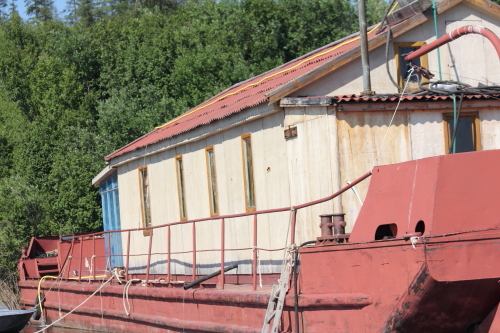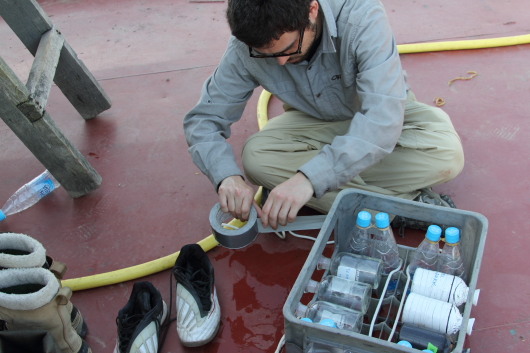Greetings from Northeast Siberia. I am in Cherskiy, where ruins of Soviet expansion litter our sampling sites. Just centimeters underground, the soil is frozen for decades on end. In the region, this soil – permafrost – can be hundreds of meters deep and continuously underlies thousands of square kilometers. To the east, countless lakes comprise more surface area than land; to the North, remnants of ice float on the Arctic Ocean.
After 3 days and 19 time changes, we land over the 4 km wide Kolyma River and onto the dirt runway of the Cherskiy airport. After hauling and rearranging our dozens of giant bags dozens of times, we only have one more short bus ride our final destination.
A barge floats on the Panteleikha River, its hull dulled red by Artic sun and snow. The faded color is understandable – the seasons are relentless: twenty-four hours of sun in the summer, twenty-four hours of darkness in the winter. Thirteen people sleep aboard: 4 primary investigators and 9 students. I have the privilege of bunking in the self-proclaimed international room with Eirik from Norway and Mantsa from Russia. Our team has more nationalities — England, Netherlands – forming a collaborative effort to enhance the understanding of arctic climate change.

Our home here in Siberia is a barge on the Panteleikha River. This is where we will eat, sleep and relax after long days in the field or lab doing science. © Becky Tachihara
Up the steep dirt path, the Northeast science station forms a small compound. A dozen buildings building sprawl onsite, but we occupy only a few. The most iconic is Orbita. A massive satellite dish rests on the roof of that octagonal building, on concrete stilts to keep from sinking into the permafrost. I am doubtful about the explanation of its purpose: broadcasting television to the people during the earlier times (how Russians refer to the USSR).
On the way to Orbita, I pass a derelict wooden church on the high riverbank. It is barely taller than me with wooden walls, a green metal roof, and a steeple. I understand why it was built there; the church overlooks a stunning and sacred place. An overflow channel of the Kolyma forms a confluence with the smaller Panteleikha River. The milky coffee-colored water mixes with the darker blue of the Panteleikha. Dissolved organic carbon – an obscure concept – becomes clear.
Organic carbon is a phrase thrown around the barge almost as much as laughter. Although it’s significance does not need explanation to the group, brown water is the reason why we are here. Organic matter is frozen in the soil beneath the ground. Heat seeps into the soil as summer arrives every year with its never-ending daylight. This deepening thaw depth is called the active layer. Will the active layer increase over time with arctic warming? How will this increased thaw depth affect the amount and type of carbon in the watershed?
Organic matter is the carbon-based remnants of photosynthesis. The molecules can be tens of thousands of years, stored in the frozen soil. As thaw depth increases, so does the age of the organic matter. Previously locked in the ice, this carbon is released into an active system. This vintage carbon forms a buffet for microbes who dine and exhale methane or carbon dioxide, further exacerbating the warming which created its initial release.
This place, with its foundation of Pleistocene (the time period before the last ice age, around 40,000 years ago) permafrost, is a science playground. We divide our efforts in to two ambitious categories. The aquatic survey gathers data quantifying how much carbon is flowing through rivers, lakes, and streams. The terrestrial survey does the same by extracting tree cores and combusting plants to derive out how much carbon is stored in vegetation.

To gather data for his project, Matt pieced together an apparatus he calls “the milk crate of science.” Using water samples from the milk crate, he will measure dissolved oxygen in order to determine microscopic photosynthetic activity. © Becky Tachihara
By combining these surveys, the Polaris Project attempts a complete understanding Kolyma’s watershed, the sixth largest river in the arctic. The project’s lead scientist, Max Holmes, wrote a paper showing the six rivers in the Arctic watershed, including the Kolyma, have been increasing in flow over the last 80 years. Our measurements attempt to understand what will happen as the flow of the river increases the amount of carbon in the water. Carbon is food. When there is more in the river, microscopic organisms eat more (respire). However, just like us, microbes prefer food that is easy to eat. This ease of eating is called lability. The students, under the guidance of the primary investigators, created experiments to understand if organic carbon will breakdown en route to the ocean.
We are here in rugged and remote Cherskiy to understand how labile the carbon is as the weather warms and more permafrost thaws. Where the hot day never ends and rarely drops below 25 C, a barge full of excited and creative scientists tempt and tease out information about climate change where it is visually happening. However, visual evidence (despite its artistic merit) is anecdotal. Our project’s aim is to quantify this release of carbon from the thawing soil.
I hope to continually update this blog to inform the public of the fascinating feedbacks and information we are obtaining in the field. The updates may be periodic. We have taken to calling our connection the “inter-nyet”. More importantly, temptations — Russian cooking from our outstanding chef Valentina, and sample procurement and processing — beckon.




Comments(3)-
-
Julie Shufro says
July 15, 2011 at 3:36 pmMatt, I just received your post via my sister via your mom. I am so excited to read about your work. It is so interesting–you make it so interesting to read about. Can’t wait to read more. -Julie Shufro, from Chicago where the weather this year is, anecdotally, weird!
Mary Jo Maute says
July 18, 2011 at 3:52 pmHi Matt –
We all miss you here in Bellingham. I’ll share your post with some of your friends at the Museum and family. I’m glad to see you have plenty of duct tape on board. It probably works to reattach appendages too!
Mary Jo